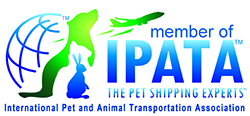
Pet transport for snub nosed breeds can be more complicated as not all airlines accept them
Certain breeds of dogs and cats have a skull conformation described as brachycephalic. This is due to the cartilage development of the base of the skull resulting in a snub-nosed appearance. Brachycephalic literally means short headed or broad headed. This occurs in animals where the length of the head is shorter than the width.
Pets with snub noses require a larger cage allowing more ventilation as air might affect them differently than it would long nosed animals. Temperature, humidity and stress (noise and movement) during carriage, combined with individual risk factors such as the animal’s temperament, age and general state of health result in an increased risk for brachycephalic breeds.
Brachycephalic pets are more at risk for respiratory distress, injury or sickness due to their breathing difficulty caused by the shorter noses and odd shaped palates.
Free Quote Form Phone or Email Us
Brachycephalic dog breeds
Following is a list of dogs that are classified as brachycephalic, or might have brachycephalic tendencies during air travel:
Affenpincher, American bulldog, American cocker spaniel, American Pit Bull Terrier, American Staffordshire Terrier, Boston Terrier, Boxer, Brussels Griffon, Bulldog, Bullmastiff, Cane Corso, King Charles Spaniel, Chihuahua (apple headed), Chow Chow, Dogo Argentino, Dogue de Bordeaux, French Bulldog, Japanese Chin, Lhasa Apso, Neapolitan Mastiff, Newfoundland, Pekingese, Presa Canario, Pug, Shap-Pei, Shih Tzu and Tibetan Spaniel.
Brachycephalic cat breeds
Following is a list of cats that are classified as brachycephalic, or might have brachycephalic tendencies during flights: British shorthair cat, Burmese cat, Exotic shorthair cat, Himalayan cat, Persian cat and Scottish Fold cat.
Air New Zealand requirements to ship brachycephalic pets
Avoid excessive temperatures: Where possible Air New Zealand recommends that flights be selected that leave/arrive in countries that have high temperatures, in the morning/evening when the temperature is lower.
Use the most direct flights available and avoid stop over’s where expected temperatures or humidity differs significantly from the normal conditions the animal has been exposed to.
Ensure your pet travels in a cage that is larger than normally required with ventilation on all four sides. Ensure no food is in the cage during the flight (your pet might choke); ensure that more than enough water is provided.Acclimatise your pet to the cage by letting it spend time in the cage several days/weeks before departure.
Several airlines will not accept snub nose breeds on board their flights. The airlines that do accept snub nose breeds require the owner complete the acknowledgement and indemnity form; stating that all the above requirements have been met and that the airline is not responsible for the health of your pet.
Where does that leave snub-nosed breeds?
Brachcephalic or snub nosed pets are more at risk to respiratory distress than their long nosed counterparts. It is important that you follow the requirements for flight to a tee otherwise your pet may suffer needlessly. When the pet is not calm he/she will have even more difficulty breathing due to the excitement or stress. Try to manage your flights not to expose your pet to extreme temperature or humidity changes, and try to use flights that land in the cooler part of the day. Please consult the veterinarian that is performing the check up in regard to additional measures that might assist your pet during the journey. If you need any more information regarding travel containers or pet transport you are welcome to contact us.

